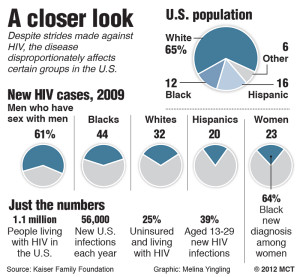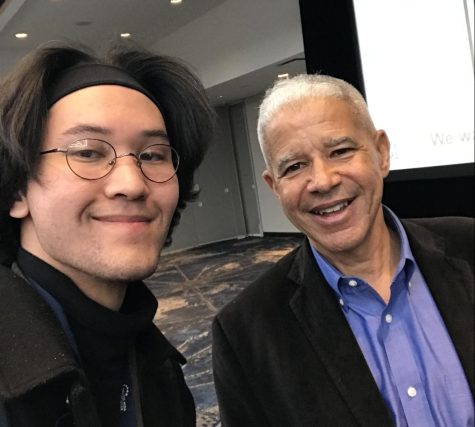Your Best Friend’s Boyfriend’s Friend has HIV
February 7, 2013
Since the epidemic boom of AIDS in the 1980’s, HIV continues to rise among America’s young people.
Many have chosen to live under the assumption that HIV and AIDS is no longer a threat to the community. According to the CDC (Center for Disease Control), as of 2010, approximately 1 in 4 people infected with HIV are between the ages of 13 to 24 years old. Nearly 60% of youth are walking around with HIV and don’t know it. This will lead to more youth being infected in the years to come.
Sex education has been apart of school curriculum since the 1970‘s. Ericka Dennis, Youth Program Coordinator for CARES (Center for Aids Research Education & Services) said, “Lack of education, lack of resources or scared of finding resources.” She continued. “A lot of our youth don’t get the opportunity to get full education on sexual health. You might get a class or a semester in high school but it’s so much information that it needs to be constant. The youth aren’t informed. They really do need more information in school otherwise you’re going to continue to see those numbers rise because they don’t have the outlets or the resources that they need.”
DJ tested positive for HIV years ago. The doctors said he could’ve been infected for as long as ten years. After testing positive using the Rapid Oral HIV test, he went in for a blood test. The results came back. His HIV had become AIDS. “That’s very interesting because I was living in Jacksonville, Florida and that was one of the top in STDs and AIDS in the south outside of Atlanta, Miami… Jacksonville was number one.” He explained, “Even knowing that it still didn’t stop what I did because you have this somewhere from out of nowhere mentality of that’s not gonna happen to me. I’m not gonna get AIDS. That’s not gonna be me.”
The shock of testing positive was a difficult situation for DJ to overcome. “I kinda went on like this emotional downward spiral. To the point to where I found myself wanting to kill myself. Not necessarily you know cut my wrist or take some pills or something. It was just not doing what’s necessary for me to stay alive. So it was kinda like neglect. It was kinda like a slow suicide. It was just like, if this is what I got, this is how I’m gonna go out. Take me out. Just end it all. It’s kinda like a real embarrassing thing. I think that’s what really gets you to go down that spiral. Ok, I have AIDS and now I have to tell people I have AIDS.”
DJ was in his twenties when he tested positive for HIV. Due to his lack of education about the virus he assumed the worst. “If we’re in the schools we’re in the places educating people that there is life after AIDS if I know that going in, a positive test really has a small effect as opposed to someone who isn’t educated. If I’m educated and well versed in what’s going on it’s more of a relief to me,” he said.
Another reason the numbers could be rising for young people could be that they are finally deciding to get tested. Ericka Dennis explains why there is a spike in HIV infections. “The numbers are still steadily rising they haven’t dropped in a long time. We’re noticing that the rates of HIV, at least for our clinic, are pretty steady.
At the same time, I do feel that CARES does go out into the community a lot and we reach out to schools and health fairs we go out to various events. So we may see a lot of numbers rise because maybe our efforts are increasing so that we might see a big jump of people being positive because we’re finally finding them. So that could also be a trend as well. So, there might be outreach efforts that are helping the numbers rise so we can find them treat them and stop the spread of HIV.”
It’s no coincidence that the numbers for HIV infected youth were high in 2010. In 2009, CVS stores decided to make access to condoms a little tougher for everyone by locking them up. Locking up condoms has created a barrier between youth and safe sex.
CVS explained that they locked up their condoms in certain areas where theft is common. The problem is, those areas are urban areas and most are populated by a majority of people with HIV and AIDS. Today, condoms continue to be locked up in several different stores including CVS and Wal-Mart, in areas where there should be access.
Bay Positives is the first peer-run agency in the world for youth living with HIV and AIDS. Peer Educator Julio Gonzalez, tested positive for HIV at 18 years old. “That’s kind of embarrassing when you’re like 18 or 16 trying to have sex. Can you unlock the magnums for me? … When I read about that it kind of made me mad,” Gonzalez said.
Condoms protect against HIV and AIDS. It’s a public safety issue. DJ added, “You shouldn’t even have to buy condoms… $15 a box? Do you really want people to use condoms? They should be free everywhere.”
California State University East Bay student Kameron Wicks has experience with HIV infected youth. “I had the honor to volunteer with an amazing non-profit organization called AIDS Project Los Angeles … When I volunteered they placed me in the food bank area where I assisted with putting together grocery bags for all of the clients.
As the clients started coming in by groups of 20 I started to see that HIV/AIDS was not only something homosexuals or older people have, but the diversity of the crowd was unfathomable. This experience was enlightening due to the fact that there were many young men and women between the ages of 18-25 that were diagnosed with HIV/AIDS.” Wicks said, “I went from always thinking that this was only something in the homosexual community, but now this is becoming an outbreak beyond that. Volunteering with APLA helped me realize that I do not know enough about HIV/AIDS!” Luckily for Kameron, according to National College Health Assessment (NCHA), the number of HIV infections for Cal State East Bay is 1.1%.
The invincible mentality among youth today is one that’s hard to break. These youth think the worst thing that could happen is an unplanned pregnancy. Somewhere information being passed down from generation to generation has become lost in translation.
The truth is regardless of education, locked condoms or a sense of invincibility, nothing can stop the rise of HIV numbers among youth except for the young people themselves. There are numerous resources out there but if the people are not willing to take the responsibility to prevent infections, the numbers will continue to rise.
If you’re sitting with 3 other people, chances are one of them is infected with HIV. If not, the infected person could be you.
















